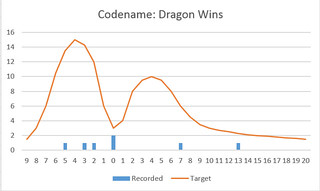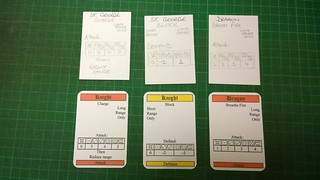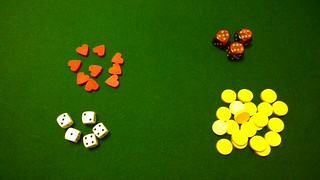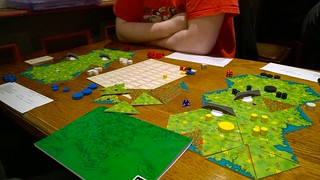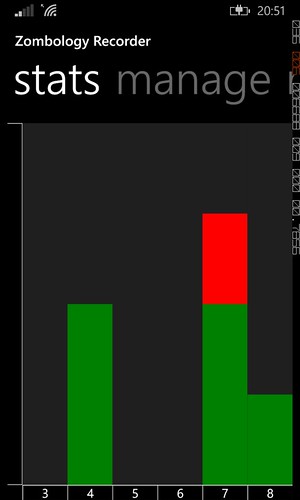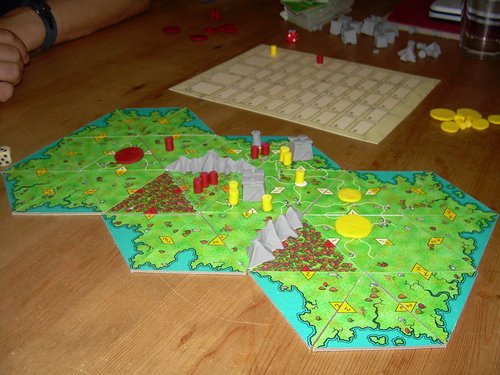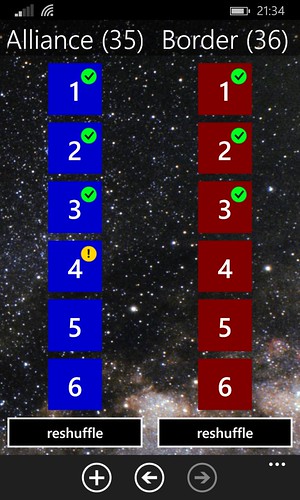I wrote this blog post on Monday night, but I've been waiting to post it until I had a chance to test it, to avoid the problems I had with the last version. Then I got sick, missing a couple of days' work and then finally we've had some bad news and I'm off again, so no real chance to test it. Seeing as Derek and Enrique have both requested it in time for the weekend, here it is. Hopefully it's better than the last version, it is at least possible for the knight to win this one!
As I feared the
last version was pretty unbalanced. Sam and I played it three times on Monday lunchtime with the dragon winning by 10 points twice and by 15 once! All in under 10 minutes :-(. I'd made the Breathe Fire work at long and short range and added another dragon attack (the Tail Lash) at long range. Despite the better defence cards for the knight he was still hopelessly out-classed. Discussing it afterwards with Sam I was quite happy with his idea that the dragon would win more games than the knight (if only slightly), but as it stood, the knight had no chance.
So, in fairly short order, here's a new version. This version has even more asymmetry added, now the knight has 9 cards and the dragon only 7. The knight's extra card is a short range defence that can be combo-ed with an attack or two, and the dragon has lost the Tail Lash and Breathe Fire is back to long range only.
New rules follow, with new print and play files at the bottom.
Dragon Dance
Fire v. Lance
2 players
10-30 mins
10+?
Contents:
9 Knight action cards
7 Dragon action cards
1 Knight player aid card
1 Dragon player aid card
9 heart tokens representing the knight's life force
20 gold coins representing the dragon's life force
3 large red dice for the dragon
5 small white dice for the knight
Dragon Dance is a game of bluff, cards and dice between a knight and a dragon in a mortal fight over the King's daughter.
Aim of the Game
The aim of the game is to reduce your opponent to zero life force through cleverly timed attacks without running out of your own life force. Each round you will simultaneously choose a die and then a card to action - either attacking, defending or manoeuvering as you dance around each other looking for an opening to exploit. The dragon is more powerful and has more life force, but it's also less agile and slower, so the knight has to strike fast before his limited life force is extinguished. The game weaves between long and short range as combatants close and retreat to catch each other on the wrong foot.
Setup
Decide between yourselves who will play the dragon and the knight. The dragon player takes the dragon player aid, action cards, three red dice and the twenty gold coins to represent its life force. The knight player takes the knight player aid, action cards, five white dice and nine heart tokens representing his life force.
Both players roll all their dice and place them in front of them and place their player aid cards with the 'Long Range' side face up nearby.
Play
The game takes place over a number of rounds during which the players act simultaneously. Throughout the game the players' life tokens, remaining dice and played cards are kept open so that both players can see them.
Each round consists of four phases:
- Choose a die (or none)
- Choose a card
- Action the card
- Discard card and die
Choose a die
In the first phase, both players simultaneously choose either one of their remaining dice, or none. High values boost attacks, low values boost defence and medium values boost both attack and defence but to a lesser degree.
During this phase, hide your remaining dice from your opponent and then choose one of them to use this turn (by, for example, placing a finger on it) or choose none (by, for example, placing a finger on the table next to your dice). Then reveal your dice along with your selection. The chosen die will be used to either boost an attack or defence card, or as a bluff to trick your opponent into playing a sub-optimal card.
Choose a card
Once both players have revealed their chosen die (or none), both players simultaneously chose a card to play this turn. The chosen cards are placed face down on the table in front of them and then when both players have chosen the cards are revealed. Chosen cards must be playable at your current range, check your player aid to see which cards you can play at your current range, or check the 'Short range' or 'Long range' icons on the cards in your hand. You begin the game at long range. The only effect of the short and long range icons is to limit the cards available to you during this phase. If one or both players play a card which changes the range, the cards chosen are still valid as long as they were valid choice at the starting range this round.
Action the card
Both cards are actioned simultaneously.
Attacks & Defence
If either player chooses an attack card, calculate the damage they deal as follows:
If they have chosen a die, use the table on the card to determine how much damage they are dealing, if no dice is chosen determine damage using the no dice column in the table.
If their opponent has not played a defence card, they lose life force equal to the damage dealt.
If their opponent has played a defence card, use the table on the defence card (along with any die chosen) to determine the defender's protection as for the attack damage. The attacker's damage minus the defender's protection is the amount of damage dealt to the defender.
Example 1:
Konrad (the knight) chooses a '5' and the Hack attack card and Derek chooses a '1' and the Flap defence card. With a 5, the Hack deals 3 damage, but the Flap and a 1 prevent 4 damage, so no damage is dealt.
If both players attack, the damages are calculated and dealt simultaneously, possibly killing each other at the same time.
Example 2:
Roberto (the knight) chooses a '6' and the Charge card and Todd chooses a '3' and the Breathe Fire card. With a 6, the Charge deals 5 damage, which is unblocked, so the dragon loses 5 life force. Breathe Fire with a 3 deals 3 damage, so the knight loses 3 life force.
Charge
The knight has the Charge card, which is a very powerful long range attack, combined with a reduce range movement. After dealing damage, if any, resolve the movement as described under 'Movement' below. For example, in Example 1 above, the combatants would now be at short range.
Dodge
The knight has a Dodge card which if played reduces damage dealt to him this round to zero regardless of what attack the dragon performs.
Example 3:
Jack (the knight) chooses a '4' and the Dodge card. Sam chooses a '5' and the Rake card. Sam's attack would have dealt 3 damage to the knight, but the Dodge reduces that to zero, so no life force is lost.
Knight's Block
The knight also has a block card which reduces damage dealt. If the dragon player has played an attack card and a die, the block will reduce the value on the die before calculating the damage dealt. This could reduce the damage dealt to zero. The amount the dragon's die roll is reduced by depends on the die the knight used in conjunction with it: with a 1,2 or a 3 the dragon's die result is reduced by two, with a 4, 5, or a 6 it is reduced by one. If used without a die it has no effect or against a defence or maneouvre card it has no effect.
Example 4:
Enrique (the knight) chooses a '4' and the Block card. Mal chooses a '5' and the Bite card. With a '4' the Block reduces the dragon's attack die by one, so Sam's '4' is changed to a '3'. Sam's attack now deals 2 damage to the knight, instead of the 4 damage it would have dealt with a '4'.
Combo
Knight has two short range attacks Hack and Slash which have the 'Combo' keyword and one short range defence 'Riposte'.
- If a Hack or Slash is played and deals damage as described in the 'Attack and Defence' section above, the knight may perform a follow up attack using the other short range attack card.
- If Riposte is played and it successfully reduces damage dealt, the knight may perform follow up attack(s) using one or both of the short range attack cards.
You can only use Combo if the combatants remain and short range and the knight has one or two short range attack cards in his hand along with unused dice to assign to the attack(s). These attacks are undefended and deal another (two) rounds of damage this turn.
Example 5:
Konrad (the knight) chooses a '4' and Hack, while Roberto chooses a '2' and Advance. The Hack deals 2 damage to the dragon, and seeing as it dealt damage, Konrad can use the Combo effect to immediately play the Slash card from his hand (not the discard pile) along with the remaining '1' die to deal a further 1 damage, the second attack cannot be defended against. Roberto's dragon loses a total of 3 life force.
Movement
If either player has played a movement card (Charge, Advance or Retreat) then the range is adjusted:
- If one or both players reduce range you are now at short range
- If the knight plays Retreat you are now at long range
- If the dragon plays Advance and the knight plays Retreat your range remains the same
Both players must now flip their player aid cards as necessary to show the range they are now at. Both player aids must always show the same range.
Note that the knight's Advance and Retreat cards also prevent one damage if played with a die showing a 1, 2 or a 3.
Discard card and die
At the end of the round both players discard the cards they played (face up where they are visible to both players) and any die they used with it. These discarded cards and dice are unavailable to the player until they play the Recuperate card, which allows them to reclaim all discarded dice and cards, returning the cards to their hand. Once they have reclaimed the dice all their dice are re-rolled.
End of the Game
The game ends at the end of the round in which at least one player has been reduced to zero life force. If the dragon has zero life force, the knight has won regardless of whether or not he has life remaining. Otherwise the dragon wins.
Download the cards
There are two versions of the cards: either front and backs as two separate files or alternatively, all the pages as a single file interleaved for easy double-sided printing.
or

